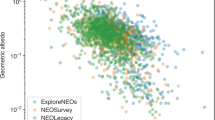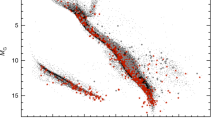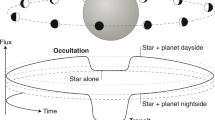Abstract
For 350 years after Galileo’s discoveries, ground-based telescopes and theoretical modelling furnished everything we knew about the Sun’s planetary retinue. Over the past five decades, however, spacecraft visits to many targets transformed these early notions, revealing the diversity of Solar System bodies and displaying active planetary processes at work. Violent events have punctuated the histories of many planets and satellites, changing them substantially since their birth. Contemporary knowledge has finally allowed testable models of the Solar System’s origin to be developed and potential abodes for extraterrestrial life to be explored. Future planetary research should involve focused studies of selected targets, including exoplanets.
This is a preview of subscription content, access via your institution
Access options
Subscribe to this journal
Receive 51 print issues and online access
$199.00 per year
only $3.90 per issue
Buy this article
- Purchase on Springer Link
- Instant access to full article PDF
Prices may be subject to local taxes which are calculated during checkout








Similar content being viewed by others
References
Harwit, M. O. Cosmic Discovery: The Search, Scope and Heritage of Astronomy (Basic Books, 1981)
Schorn, R. A. Planetary Astronomy: From Ancient Times till the Third Millennium (Texas A&M Press, 1998)
Russell, H. N., Dugan, R. S. & Stewart, J. Q. Astronomy. A Revision of Young’s Manual of the Solar System (Ginn & Co., 1926)
Doel, R. E. Solar System Astronomy in America: Communities, Patronage and Interdisciplinary Science 1920–1960 (Cambridge University Press, 1996)
Baldwin, R. B. The Face of the Moon (University of Chicago Press, 1949)
Urey, H. C. Planets: Their Origin and Development (Yale University Press, 1952)This seminal book by a Nobel-Prize-winning chemist was the first about planetary evolution and cosmogony to be written from a chemical rather than physical or astronomical perspective.
Tatarewicz, J. T. Space Technology and Planetary Astronomy (Indiana University Press, 1990)
Cadbury, D. Space Race: The Epic Battle between America and the Soviet Union for Dominion of Space (Harper Collins, 2006)
McDougall, W. A. The Heavens and the Earth: A Political History of the Space Age (Basic Books, 1985)
Shklovskii, I. S. & Sagan, C. Intelligent Life in the Universe (Holden-Day, 1966)
Burns, J. A. Sputnik, space and me. Nature Phys. 3, 664–668 (2007)
Kepler: a Search for Habitable Planets 〈www.kepler.arc.nasa.gov〉. (Ames Research Center, NASA, 2010)
Bagenal, F., Dowling, T. E. & McKinnon, W. B. (eds) Jupiter: The Planet, Satellites and Magnetosphere (Cambridge University Press, 2004)
Brown, R. H., Lebreton, J.-P. & Waite, J. H. (eds) Titan from Cassini-Huygens (Springer, Dordrecht, 2009)
Goldreich, P. & Tremaine, S. The dynamics of planetary rings. Annu. Rev. Astron. Astrophys. 20, 249–283 (1982)During the late 1970s and 1980s, this dynamic duo described the fundamental mechanisms that govern the interactions between planetary rings (or, equivalently, protoplanetary disks) and nearby masses.
Cuzzi, J. N. et al. An evolving view of Saturn’s dynamical rings. Science 327, 1470–1475 (2010)
Wolszczan, A. & Frail, D. A. A planetary system around the millisecond pulsar PSR1257+12. Nature 355, 145–147 (1992)
Mayor, M. & Queloz, D. A. Jupiter-mass companion to a solar-type star. Nature 378, 355–359 (1995)After this first extrasolar planet around a solar-type star (see ref. 17) was announced, nearly 500 other extrasolar planets of enormous variety have been discovered, broadening the purview of planetary science.
Wright, J. T. Exoplanet Data Explorer (Exoplanet Orbit Database) 〈http://www.exoplanets.org〉 (2010)
McKay, D. et al. Search for past life on Mars: possible relic biogenic activity in martian meteorite AL84001. Science 273, 924–930 (1996)
Chyba, C. F. & Hand, K. P. Astrobiology: the study of life in the universe. Annu. Rev. Astron. Astrophys. 43, 31–74 (2005)
Jewitt, D. & Luu, J. Discovery of the candidate Kuiper belt object 1992 QB1. Nature 362, 730–732 (1993)An entirely new Solar System genus was disclosed when this large icy mass was spied just beyond Pluto; a thousand more23, displaying a rich orbital architecture, are now known, reaching out three times as far from the Sun.
Barucci, M. A., Boenhardt, H., Cruikshank, D. P. & Morbidelli, A. (eds) The Solar System beyond Neptune (University of Arizona Press, 2008)
Festou, M. C., Keller, H. U. & Weaver, H. A. (eds) Comets II (University of Arizona Press, 2004)
Smith, B. A. et al. Encounter with Saturn: Voyager 1 imaging science results. Science 212, 163–191 (1981)This instalment of Voyager ’s mind-bending ‘30-day’ reports that followed each planetary fly-by displayed Saturn’s surprisingly complex rings, described Titan’s atmosphere, and argued that some small satellites had been disrupted several times.
Dougherty, M. K., Brown, R. H. & Esposito, L. W. (eds) Saturn After Cassini-Huygens (Springer, 2009)
Bougher, S. W., Hunten, D. M. & Phillips, R. J. (eds) Venus II: Geology, Geophysics, Atmosphere and Solar Wind Environment (University of Arizona Press, 1997)
Bell, J. (ed) The Martian Surface: Composition, Mineralogy and Physical Properties (Cambridge University Press, 2008)
Carr, M. H. The Surface of Mars (Cambridge University Press, 2007)
Burns, J. A. & Matthews, M. S. (eds) Satellites (University of Arizona Press, 1986)
Steinbacher, R. H. et al. Mariner 9 science experiments: preliminary results. Science 175, 293–323 (1972)This contains the initial reports from the first orbiter of another planet, which would eventually survey Mars’s enormous volcanoes, the Solar System’s largest rift system, apparent river valleys, atmospheric phenomena (including dust storms) and remarkable tiny moons.
Burns, J. A., Lamy, P. L. & Soter, S. Radiation forces on small particles in the solar system. Icarus 40, 1–48 (1979)
Bottke, W. F., Vokrouhlicky, D., Rubincam, D. P. & Nesvorny, D. The Yarkovsky and YORP effects. Annu. Rev. Earth Planet. Sci. 34, 157–191 (2006)
Whipple, F. L. A comet model I. The acceleration of comet Encke. Astrophys. J. 111, 375–394 (1950)
Brownlee, D. et al. Comet 81P/Wild 2 under a microscope. Science 314, 1711–1716 (2006)
Wyatt, M. C. Evolution of debris disks. Annu. Rev. Astron. Astrophys. 46, 339–383 (2008)
Wisdom, J., Peale, S. J. & Mignard, F. The chaotic rotation of Hyperion. Icarus 58, 137–152 (1984)
Touma, J. & Wisdom, J. The chaotic obliquity of Mars. Science 259, 1294–1297 (1993)
Laskar, J. & Gastineau, M. Existence of collisional trajectories of Mercury, Venus and Mars with Earth. Nature 459, 817–819 (2009)
Tera, F., Papanastassiou, D. A. & Wasserburg, G. J. Isotopic evidence for a terminal lunar cataclysm. Earth Planet. Sci. Lett. 22, 1–21 (1974)
Wilhelms, D. E. The Geological History of the Moon (USGS Professional Paper 1348, 1987)
Alvarez, L. W., Alvarez, W., Asaro, F. & Michel, H. V. Extraterrestrial cause for the Cretaceous-Tertiary extinction. Science 208, 1095–1108 (1980)
Noll, K. S., Weaver, H. A. & Feldman, P. D. (eds) The Collision of Comet Shoemaker-Levy 9 and Jupiter (IAU Colloquium 156, Cambridge University Press, 1996)
Hess, H. H. in Petrologic Studies (eds Buddington, A. F., Engel, A. E. J., James, H. L. & Leonard, B. F.) 599–620 (Geological Society of America, 1962)
Malin, M. C. & Edgett, K. S. Evidence for persistent flow and aqueous sedimentation on early Mars. Science 302, 1931–1934 (2003)
Malin, M. C., Edgett, K. S., Posilova, L. V., McColley, S. M. & Noe Dobrea, E. Z. Present-day impact cratering rate and contemporary gulley activity on Mars. Science 314, 1573–1577 (2006)
Hubbard, W. B., Burrows, A. & Lunine, J. I. Theory of giant planets. Annu. Rev. Astron. Astrophys. 40, 103–136 (2002)
Dole, S. H. Habitable Planets for Man (Blaisdell, 1964)
Postberg, F. et al. Sodium salts in E-ring grains from an ocean below the surface of Enceladus. Nature 459, 1098–1101 (2009)
Brush, S. G. Fruitful Encounters. The Origin of the Solar System from Chamberlain to Apollo (Cambridge University Press, 1996)
Patterson, C. C. The age of meteorites and the Earth. Geochim. Cosmochim. Acta 10, 230–237 (1956)
Lauretta, D. S. & McSween, H. Y. (eds) Meteorites and the Early Solar System II (University of Arizona Press, 2006)
Beckwith, S. V. W. & Sargent, A. I. Circumstellar disks and the search for neighbouring planetary systems. Nature 383, 139–144 (1996)
Smith, B. A. & Terrile, R. J. A circumstellar disk around Beta Pictoris. Science 226, 1421–1424 (1984)
Deming, D. & Seager, S. Light and shadow from distant worlds. Nature 462, 301–306 (2009)
Chambers, J. E. Planetary migration: what does it mean for planet formation? Annu. Rev. Earth Planet. Sci. 37, 321–344 (2009)
Safronov, V. S. Evolution of the Protoplanetary Cloud and the Formation of the Earth and the Planets [in Russian; Nauka, 1969] (translated NASA TT-F-677; Keter Press, 1972)
Greenberg, R., Hartmann, W. K., Chapman, C. R. & Wacker, J. F. Planetesimals to planets—numerical simulations of collisional evolution. Icarus 35, 1–26 (1978)
Richardson, D. C. & Walsh, K. J. Binary minor planets. Annu. Rev. Earth Planet. Sci. 34, 47–81 (2006)
Fujiwara, A. et al. The rubble-pile asteroid Itokawa as observed by Hayabusa . Science 312, 1330–1334 (2006)
Wetherill, G. W. Formation of the terrestrial planets. Annu. Rev. Astron. Astrophys. 18, 77–113 (1980)
Hartmann, W. K. & Davis, D. R. Satellite-sized planetesimals and lunar origin. Icarus 24, 504–514 (1975)
Canup, R. M. Lunar-forming collisions with pre-impact rotation. Icarus 196, 518–538 (2008)
Udry, S. & Santos, N. C. Statistical properties of exoplanets. Annu. Rev. Astron. Astrophys. 45, 397–439 (2007)
Fernandez, J. A. & Ip, W.-H. Some dynamical aspects of the accretion of Uranus and Neptune—the exchange of angular momentum with planetesimals. Icarus 58, 109–120 (1984)
Duncan, M. J., Quinn, T. & Tremaine, S. The origin of short-period comets. Astrophys. J. 328, L69–L73 (1988)
Tsiganis, K., Gomes, R., Levison, H. F. & Morbidelli, A. Origin of the orbital architecture of the giant planets of the Solar System. Nature 435, 459–461 (2005)
Kalas, P. et al. Optical images of an extrasolar planet about 25 light-years from Earth. Science 322, 1345–1347 (2008)
Marios, C. et al. Direct imaging of multiple planets orbiting the star HR8799. Science 322, 1348–1352 (2008)
Abelson, P. H. (ed) Summary of the Apollo 11 Lunar Science Conference. Science 167, 449–784 (1970)The chemistry, mineralogy, and petrology of the first lunar samples are discussed, as well as measurements of the surface instruments, following presentations at the inaugural annual meeting in Houston.
Wisdom, J. & Holman, M. Symplectic maps for the n-body problem. Astron. J. 102, 1528–1538 (1991)Numerical simulations became much more powerful once this efficient integration scheme and later variants72,73 entered general use.
Duncan, M. J., Levison, H. F. & Lee, M.-H. A multiple-time-step symplectic algorithm for integrating close encounters. Astron. J. 116, 2067–2077 (1998)
Morbidelli, A. Modern integrations of solar system dynamics. Annu. Rev. Earth Planet. Sci. 30, 89–112 (2002)
Peale, S. J., Cassen, P. & Reynolds, R. T. Melting of Io by tidal dissipation. Science 203, 892–894 (1979)
Denk, T. et al. Iapetus: unique surface properties and a global color dichotomy from Cassini imaging. Science 327, 435–438 (2010)
Porco, C. C. et al. Cassini observes the active south pole of Enceladus. Science 311, 1393–1401 (2006)
Burrows, W. E. Voyages in the Solar System and Beyond (Random House, 1990)
Laskar, J., Levard, B. & Mustard, J. F. Orbital forcing of the martian polar layered deposits. Nature 419, 375–377 (2002)
Cruikshank, D. P. & Chamberlain, J. W. in The American Astronomical Society’s First Century (ed. DeVorkin, D. H.) 252–268 (American Institute of Physics, 1999)
Planetary Science Decadal Panel 〈www8.nationalacademies.org/ssbsurvey/publicview.aspx〉 (The National Academies, 2010)
Acknowledgements
B. Byington, J. K. Burns, C. R. Chapman, D. P. Cruikshank, M. M. Hedman, T. Owen, D. Tamayo, P. C. Thomas, M. S. Tiscareno and especially Jeffrey N. Cuzzi provided advice on previous drafts of the manuscript. I thank the Isaac Newton Institute of the University of Cambridge, where this article was principally written, for its hospitality. Figures 1a, 2a, 3a, 4a, 5a, 6a, 7a and 8a are provided courtesy of the Division of Rare and Manuscript Collections, Cornell University.
Author information
Authors and Affiliations
Corresponding author
Ethics declarations
Competing interests
The author declares no competing financial interests.
Rights and permissions
About this article
Cite this article
Burns, J. The four hundred years of planetary science since Galileo and Kepler. Nature 466, 575–584 (2010). https://doi.org/10.1038/nature09215
Issue Date:
DOI: https://doi.org/10.1038/nature09215
Comments
By submitting a comment you agree to abide by our Terms and Community Guidelines. If you find something abusive or that does not comply with our terms or guidelines please flag it as inappropriate.



